Hannah Emerson Duston was born on 23 December 1657 in Haverhill, MA to Michael Emerson of Cadney, England and Hannah Webster of Ipswich, MA. Born into a puritan family she would marry Thomas Duston, a bricklayer, and farmer. Together the couple would have 13 children.
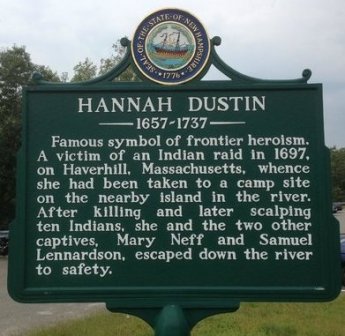
The couple’s first house was on the western side of Haverhill. On 15 March 1697, a group of 20 Native Americans attacked Haverhill from the west side, with the Duston house being hit first. Thomas Duston was already outside the house and attending to the farm with his other 8 children while his wife was inside the house with their neighbor, Mary Neff, as Hannah had just given birth to Martha six days earlier.
Thomas is said to have mounted his horse and raced for the house, yelling a warning to his children, sending them running, as his horse went into a full gallop. The children ran for the garrison, which during this period would have been nearby or attached to the house; once they were safe Thomas continued on to the house, after his wife and newborn daughter. As this was happening Mary Neff, who had been to the house to help the family with the birth, tried to escape with the baby. She was unsuccessful in her escape, and she and the baby along with Hannah would become prisoners.
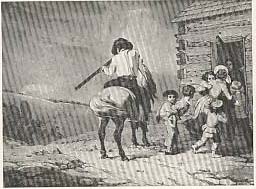
A lithograph of Thomas Duston protecting his children from Native Americans as they escaped to the Marsh Garrison House on Pecker Hill. Original image; archives of the New York Public Library.
Hannah was hardly dressed and rushed out of her bed with the intruders beginning to burn her house before she was even out the door. She was rushed from the house so fast that she only had one shoe on. The women would be forced into the woods along with others from the town who had been captured and marched north on foot, with the infant in Mary Neff’s arms. It did not take long for their captors to realize how much the infant would slow them down, and baby Martha was ripped from Mary’s arms and killed in front of the two women, by being bashed against a tree. The remaining members of the attacking party killed 27 other men, women and children.
The women were forced to pick up the pace and soon reached a meeting point where another group of Native Americans, women, and children, had been waiting. The rest of the attack party also met here, with other captives, among them Hannah Bradley, who was taken with another group northwards. The weaker captives from the attack on Haverhill were killed and scalped. Despite her condition, Hannah was not judged to be weak, and along with Mary, they were marched farther north with a different group.
By her own account, she walked 12 miles the first day, and during the next few days, they would travel over 50 more miles, on foot through the wilderness.
Near the junction of the Contoocook and Merrimack Rivers, the group of Native Americans split up, with 12 of them taking Hannah and Mary, along with a boy named Samuel Lennardson (Leonard). Samuel had been taken captive over a year earlier outside of Worcester, MA.
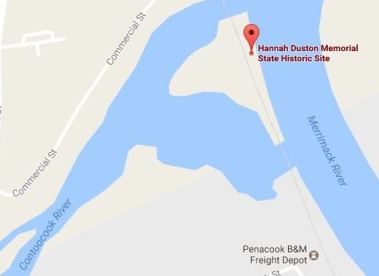
Duston Island
Samuel Leonard was born in Bridgewater, MA around 1683, and was the last child and only son of Solomon, sometimes seen as Samuel, Leonard and Abigail Atwood. During his time with his captors he learned to speak the Native’s language, and over time had been “adopted” by them. Samuel’s mother died before his return, it was said she died over the grief of his capture.
As the 3 captives were forced further north they were taken to what is now known as Duston Island. It is a small island at the confluence of the Contoocook and Merrimack Rivers. There the group was claimed by the Native American occupant of the island as his property. The group would spend the night on the island, with the Native Americas letting their guard down. No watch was set that night, with the thought process probably being that the newly captured women were too weak and that Samuel had been with them for so long that he was one of them now.
What they didn’t realize was that Hannah Duston had been forming a plan, and she got Mary Neff, and Samuel Leonard in on it too. Days before, as they had been forced to march north, Samuel had asked one of his male captors where to hit someone in the head if they wanted to kill a person. Thinking nothing of it the Native American man informed Samuel of how to do it. Samuel reported this information back to Hannah. That night on the island, once their captors were asleep, Hannah, Mary, and Samuel quickly took their axes, along with other weapons and killed them. Only two Native Americans survived and escaped, a woman and a boy.
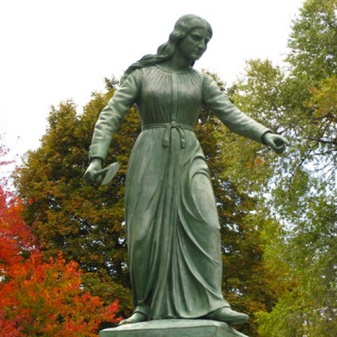
Bronze statue erected in 1879 to commemorate Hannah Duston. Statue erected in Haverhill town square. Photograph of Statue of Hannah Duston. – North of Boston. http://northofboston.org/businesses/statue-of-hannah-duston/
Hannah Bradley would not fare so well and would be marched farther north. She happened to be at the same encampment the injured Native American woman and boy had returned to, telling the story of Hannah, Mary, and Samuel, and bearing the injuries to prove it as well. It is not known how Hannah Bradley escaped, her account of the incident does not include her escape, but she also made it back to Haverhill.
Grabbing supplies and any weapons they could, the group of three filled a canoe. They sunk the rest of the canoes and set on their way south, back down the Merrimack River. Realizing the magnitude of their story, and that two of them were “just women”, they had no proof, and so they quickly returned to the island scalping their former captors as proof of their ordeal.
Back on the river, the group would only travel at night, under the cover of darkness. They stayed on the Merrimack river till the reached an area known as Old Dunstable, now Nashua, NH. There they reached the house of John Lovewell and were taken in for the night. The following morning they resumed their journey, eventually finishing it on foot.
Hannah was immediately taken to her new house, which had hastily been finished during her ordeal and time as a captive. There she would rest and recuperate.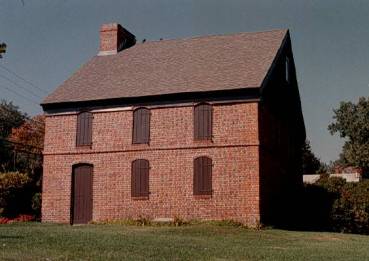
Duston Garrison House. Haverhill, MA
The year before the attack on Haverhill, in 1896, the bounty on scalps had completely ended. Thomas, Hannah’s husband, deciding that the bounty should be claimed; he set off for Boston with his wife, Mary Neff, and Samuel Leonard. The arrived a little over a month after the attack, on 21 April 1697. Thomas filed a petition to the Governor and Council, which was read in the House on 8 June 1697. On 16 June 1697, the General Court voted in favor of payment.
Hannah Duston would outlive her husband by a considerable number of years, and spent the remainder of her life residing with her son, Jonathan, who lived in the southwest side of the original farm.
Samuel Leonard would return to his family and is said to have spent a large amount of time with his uncles, Maj. William Bradford of Plymouth as well as John, Jacob, and Isaac Leonard of Bridgewater, MA. Later Samuel would join his father and sisters in Norwich, CT. There they would live in secrecy, in the north part of Preston, in what is now Griswold, CT, in fear of violent repercussions for what he had done to escape in 1697.
Hannah Bradley would suffer a second capture at the hands of Native Americans, in 1704. She refused to be captured without a fight, even heavily pregnant and killed one of the intruders to her home with scalding hot soap she had been boiling. She was overpowered by the rest of the men and taken prisoner again. Her willingness to defy and fight back would cost her. She gave birth while being held captive and the child was subject to extremely cruel treatment by the Native Americans, and would eventually die.
Hannah Bradley would suffer for two more years as a captive of the Native Americans before being sold, in 1705, to a French family near Montreal. She would spend a short time with this family before her husband, Joseph Bradley, caught word of her still being alive and where she was. He traveled on foot to Montreal, where he paid for her release. The couple would sail from Montreal to Boston and then return home to Haverhill.
The Bradley house would see a third attack, in the summer of 1706. Hannah Bradley would not be taken a third time, with it being said she told her husband “they had come for her and that she would rather be killed than taken again.” This time Hannah was armed along with her husband and a hired man. The children were also given guns, as they were big enough to shoulder them. As the attack party beat down the door, the occupants stood ready, with the long rifles loaded. Once it was partially open, one of the attackers crowded the door, and Hannah fired, killing him. The rest of the attack party retreated, deciding against a similar fate.
Mary Neff, along with the others would receive a large parcel of land for the horrors they had endured at the time of the attacks on Haverhill. This was something commonplace at the time; a way to compensate early colonists for their losses, both monetary, physically, and emotionally. Mary had been born to George Corliss and Joanna Ordway on 28 September 1646. She would marry William Neff, and together they would have 6 children. In 1739, the year after Hannah Bradley had received her parcel, Joseph Neff, petitioned the “Great and General Council” for a grant of land, due to his mother’s captivity after the attack on Haverhill in 1697. Joseph’s petition was supported by Hannah Bradley, who would also petition for a grant of land, as a widow, her husband having died over a decade before.
Hannah Duston died on 6 March 1736, her will was proven in Ipswich on 10 March 1736.
Children of Hannah Emerson and Thomas Duston:
- Hannah – 22 August 1678
- Elizabeth – 7 May 1680
- Mary – 4 May 1681 – 18 October 1696
- Thomas Jr. – 5 January 1683
- Nathaniel – 16 May 1685
- John – 2 February 1686 – 28 January 1690
- Sarah – 4 July 1688
- Abigail – October 1690
- Jonathan – 15 January 1691
- Timothy (twin) – 14 September 1694
- Mehitable (twin) – 14 September 1694 – 16 December 1694
- Martha – 9 March 1697 – 15 March 1697
- Lydia – 4 October 1698
The men, women, and children who were killed in the attack in Haverhill:
- Daniel Bradley
- Hannah Bradley – wife of Daniel Bradley
- Mary Bradley – daughter of Daniel and Hannah Bradley
- Hannah Bradley – daughter of Daniel and Hannah Bradley
- Joseph Bradley – son of Daniel and Hannah Bradley
- Martha Bradley – daughter of Daniel and Hannah Bradley
- Sarah Bradley – daughter of Daniel and Hannah Bradley
- Martha Dow – daughter of Steven Dow
- Martha Duston – daughter of Thomas and Hannah Duston
- Sarah Eastman – daughter of Deborah Corliss
- Thomas Kingsbury – son of Deborah Corliss
- Mehitable Kingsbury – son of Deborah Corliss
- Thomas Eaton
- Thomas Emerson
- Elizabeth Emerson – wife of Thomas Emerson
- Timothy Emerson – son of Thomas and Elizabeth Emerson
- Sarah Emerson – daughter of Thomas and Elizabeth Emerson
- John Keezer (Jr?)
- John Keezer (Sr?) – father of John Keezer
- George Keezer – son of John Keezer Sr.
- John Kimball
- Hannah Kimball – mother of John Kimball
- Thomas Wood
- Susannah Wood – daughter of Thomas Wood
- John Woodman
- Susannah Woodman – daughter of John Woodman
- Zechariah White
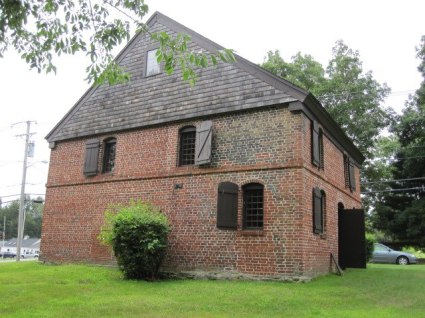
Today the Duston Garrison House still stands and is a museum. It is available for a tour by appointment. There is no charge to tour the house but donations are always welcome. You can contact Diane for more information, 978-430-4506.
There are also several monuments that have been erected in honor of Hannah Duston and the other captives, and what they had been through. One is on Duston Island, in Boscawen, NH, where she killed her captors; it still stands there today and can be visited, and was erected in 1874 and is the first publically-funded statue in New Hampshire. Another is a bronze statue that was erected in 1879 and is in the Haverhill town square, the statue is pictured above in the article. A third memorial was created in 1908 when an inscription was put on a boulder in memorial to both Hannah and Martha. The boulder was placed on the site of Hannah’s son Jonathan’s home, and can still be found in Haverhill today.
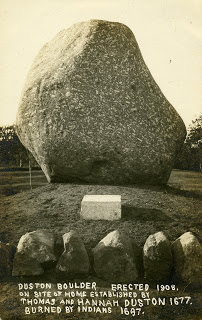
Photo Tour ~ Interior of the Duston Garrison House
Bibliography
Chase, George Wingate. The History of Haverhill, Massachusetts, From Its First Settlement, In 1640, To The Year 1860. Lowell, MA: Stone and Hush Book Printers.
Atkinson, Jay. Massacre on the Merrimack: Hannah Duston’s Captivity and Revenge in Colonial America. National Book Network, 2015.
Hoyt, David W. The Old Families of Salisbury and Amesbury, Massachusetts: With Some Related Families of Newbury, Haverhill, Ipswich, and Hampden. Vol. 1. Providence, RI, 1897.
Caverly, Robert Boodey. Heroism of Hannah Duston: Together with the Indian Wars of New England. Boston, MA: B.B. Russell & Co., 1875.
Peters, Eleanor Bradley, comp. Bradley of Essex County, early records, from 1643 to 1746: with a few lines to the present day. New York, NY: The Kinckerbocker Press, 1915.
“Duston-Dustin Garrison House.” Duston-Dustin Garrison House – Pictures. https://www.facebook.com/pg/DustonDustinGarrisonHouse/photos/?ref=page_internal.
“Hannah Duston: The Mother’s Revenge.” RoadsideAmerica.com. http://www.roadsideamerica.com/story/21105.






